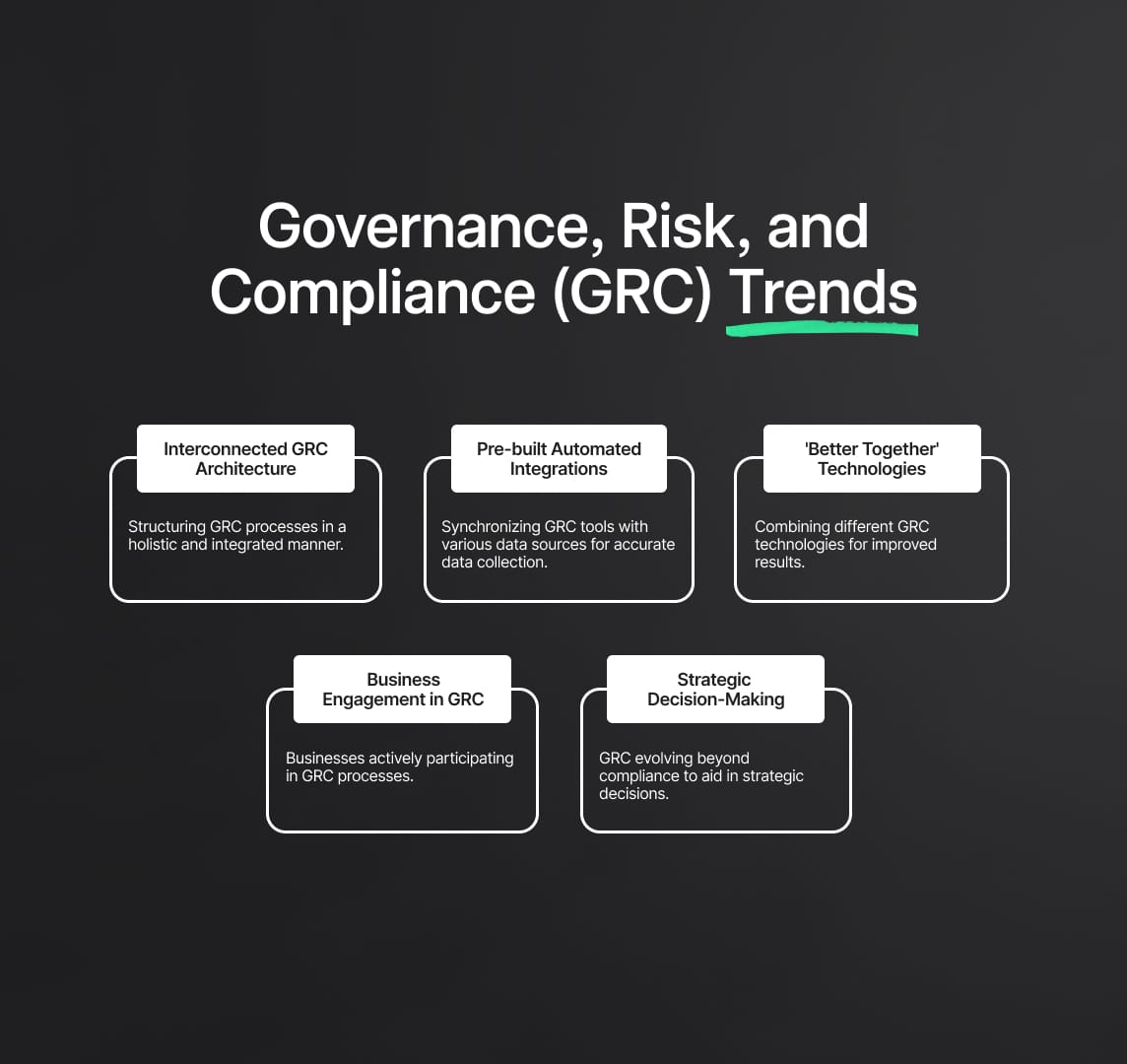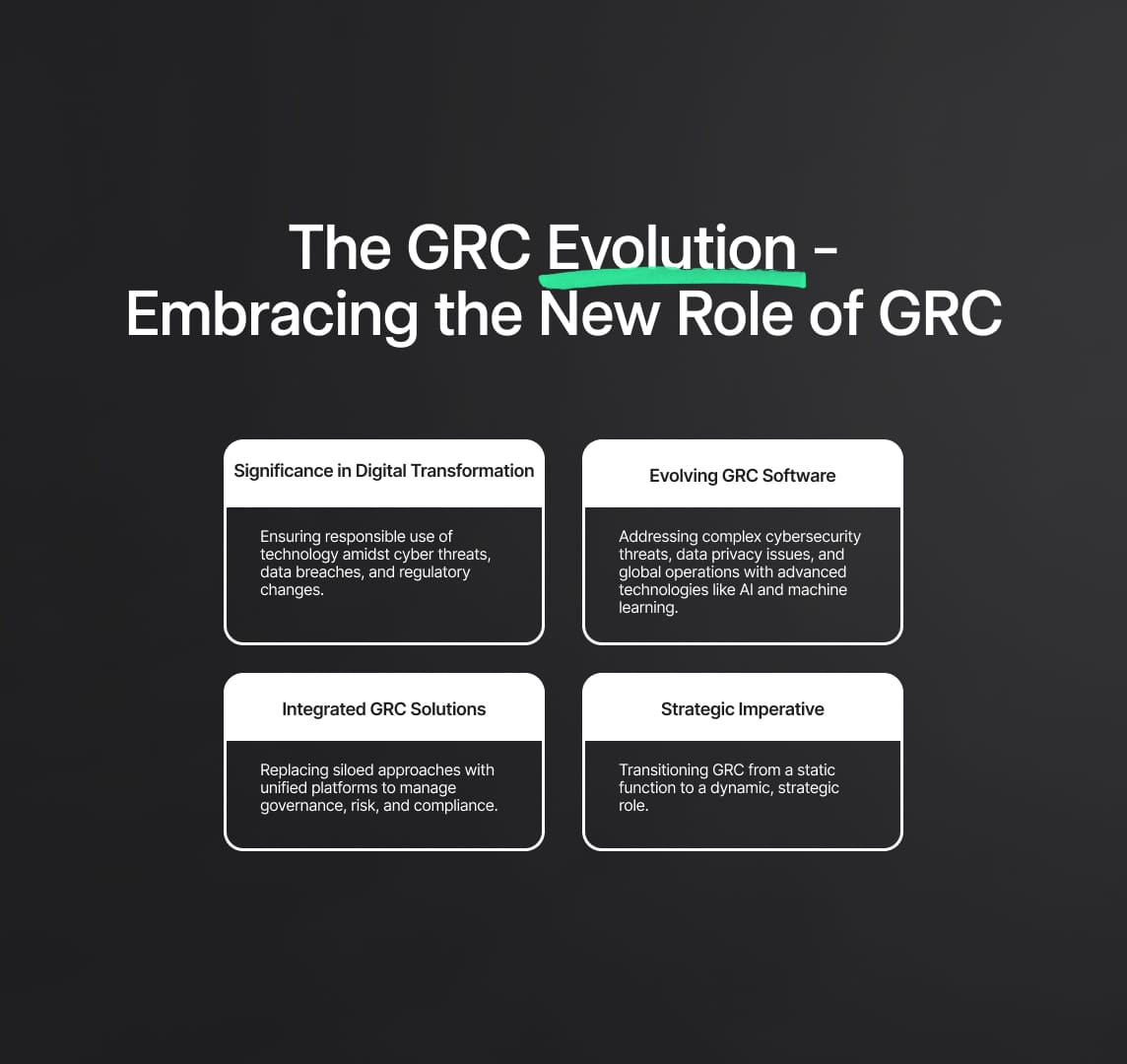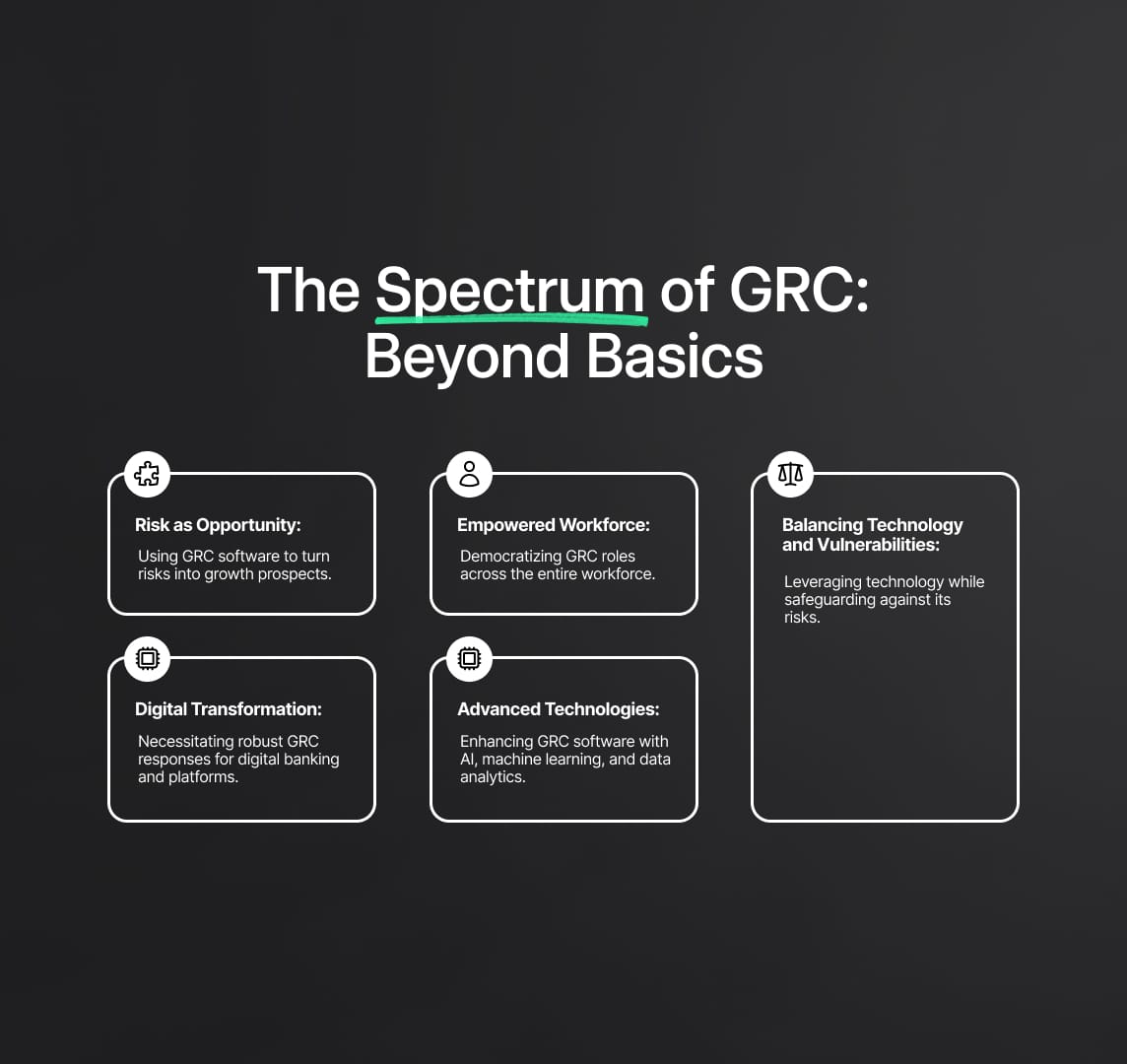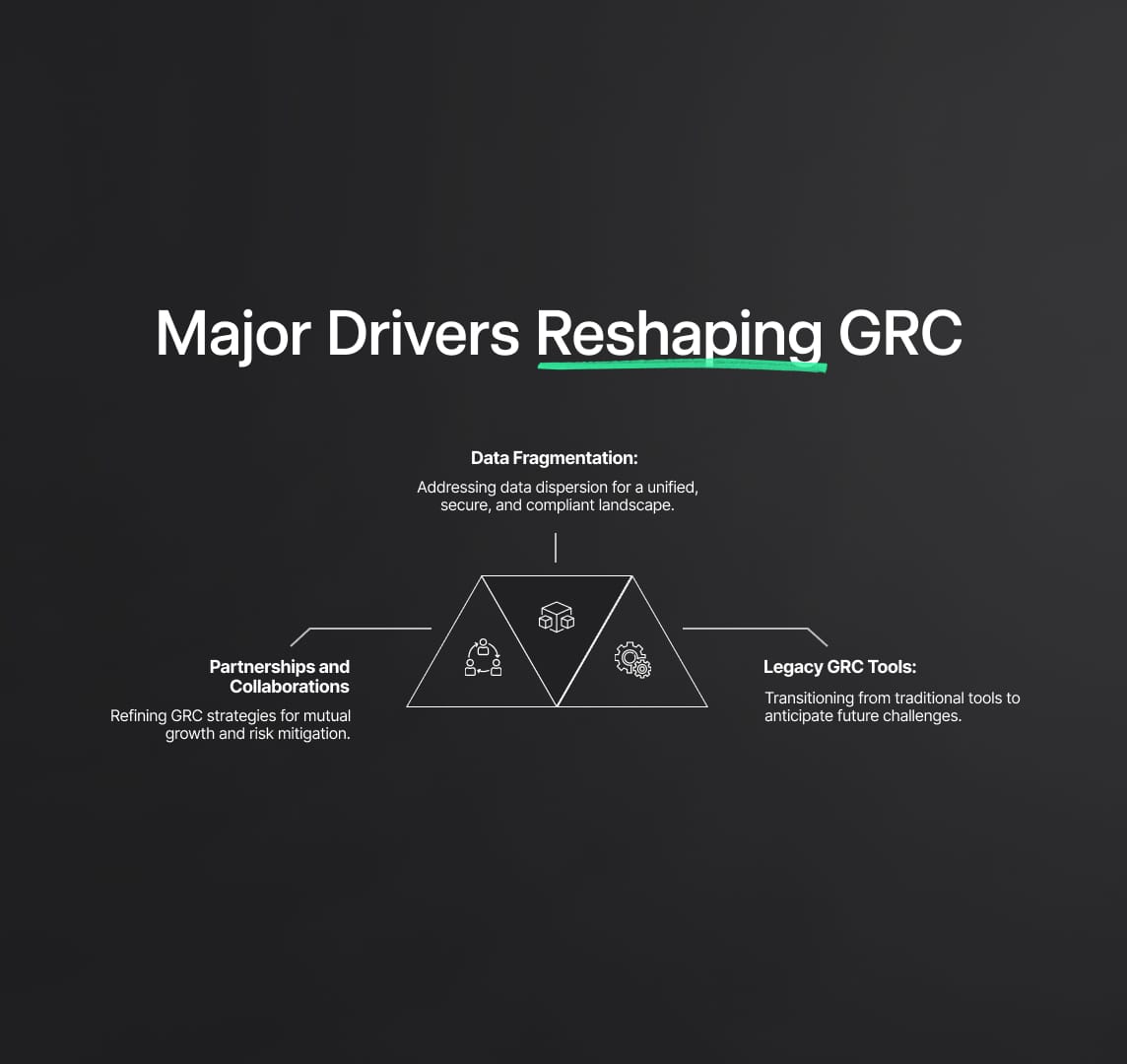Governance Risk and Compliance (GRC) Trends for 2024
2024's financial landscape is shaped by pivotal Governance, Risk, and Compliance (GRC) trends. Key strategies include leveraging AI for compliance, enhancing cybersecurity, integrating sustainability, and managing third-party risks, essential for navigating regulatory and technological changes.

As we move deeper into 2024, the financial sector is witnessing an unprecedented convergence of regulatory shifts and technological breakthroughs. This critical juncture is reshaping the landscape of governance, risk, and compliance (GRC), demanding a more sophisticated and strategic approach. Institutions are now compelled to recalibrate their operations, not only to comply with the complex regulatory frameworks but also to capitalize on the opportunities presented by technological advancements. This article provides an in-depth analysis of the evolving trends, the multifaceted challenges, and the strategic imperatives shaping the GRC landscape in 2024.

Global Shifts in Regulatory Frameworks
- Basel III Reforms: On the global front, the Basel III reforms are approaching their finalization stage. These reforms represent a significant overhaul of banking regulations, with a strong emphasis on enhancing financial stability. The focus is on instituting stricter capital controls and resilience measures designed to safeguard against future financial crises.
- Implications for Global Financial Stability: The Basel III reforms are set to have far-reaching implications for the global financial sector. Banks and financial institutions worldwide are required to bolster their capital reserves, improve risk management practices, and enhance their overall resilience. This global regulatory alignment aims to create a more stable and secure financial ecosystem.
- Strategic Adjustments by Financial Institutions: To comply with the Basel III requirements, financial institutions are undergoing strategic adjustments. This includes re-evaluating their asset portfolios, adjusting risk models, and enhancing liquidity management practices. The goal is to not only meet the regulatory standards but also to position themselves advantageously in a more regulated and secure market.
Harnessing Artificial Intelligence (AI) GRC Systems in Finance
AI-Driven Data Analysis: AI technologies are revolutionizing how financial data is processed and interpreted. Through sophisticated algorithms, AI enables the analysis of vast datasets, providing insights that were previously unattainable. This capability is invaluable in predicting market trends, understanding customer behavior, and identifying new opportunities.
Enhanced Customer Experience: AI is also playing a pivotal role in transforming customer service. Chatbots and virtual assistants, powered by AI, are providing round-the-clock service, offering personalized financial advice, and improving customer engagement. This not only enhances the customer experience but also boosts operational efficiency.
Risk Management and Compliance: AI tools are instrumental in identifying and managing risk. They can detect patterns indicative of fraudulent activities, thereby enhancing security. Moreover, AI can aid in regulatory compliance by keeping track of ever-changing regulations and ensuring adherence, which is vital in the heavily regulated financial sector.
Operational Efficiency: By automating routine tasks, AI is freeing up human resources to focus on more complex and strategic activities. This shift is leading to cost savings and increased productivity, driving operational excellence.
GRC: Blockchain for Enhanced Security and Transparency
Decentralised Ledger Technology: Blockchain, at its core, is a decentralized ledger that records transactions across multiple computers. This technology offers unparalleled security and transparency, making it highly resistant to fraud and cyber-attacks.
Smart Contracts: Blockchain enables the use of smart contracts – self-executing contracts with the terms directly written into code. These contracts automate processes and transactions, reducing the need for intermediaries, thus saving time and costs.
Cross-border Transactions: Blockchain technology simplifies cross-border financial transactions. It reduces processing times and eliminates the need for currency conversion, thereby facilitating smoother international trade.
Enhanced Compliance and Record-Keeping: Blockchain’s immutable nature ensures that financial records cannot be altered, providing an audit trail that is essential for regulatory compliance and transparent record-keeping.
Integrating AI and Blockchain for a Competitive Edge
The integration of AI and blockchain in financial institutions signifies a monumental shift in how financial services are delivered and managed. This convergence is not merely about adopting new technologies; it’s about reimagining financial services in the context of a digital-first world. Financial institutions that leverage these technologies effectively are poised to gain a significant competitive advantage. They will not only operate more efficiently and securely but will also offer superior customer experiences and innovative services.

The Rising Importance of ESG in Financial Decision-Making
- Regulatory Momentum: Governments and regulatory bodies worldwide are increasingly recognizing the importance of ESG factors in ensuring sustainable economic growth and mitigating systemic risks. Regulations are being formulated to ensure companies disclose their ESG practices, aiming to standardize reporting and increase transparency. This regulatory shift is compelling companies to integrate ESG considerations into their risk management and strategic planning processes.
- Investor Demand: The investor community, including institutional investors and individual shareholders, is showing a growing preference for ESG-compliant companies. This shift is driven by the understanding that companies with strong ESG credentials are likely to perform better in the long term, both in terms of financial returns and sustainability. As a result, there's an increasing allocation of capital towards ESG-focused investments, making it an essential criterion for investment decisions.
- Public Awareness and Social Responsibility: There is a heightened public awareness regarding environmental issues, social justice, and corporate governance standards. Consumers and stakeholders are demanding more from businesses in terms of their contribution to societal and environmental goals. This public pressure is pushing companies to adopt more transparent and responsible ESG practices.
ESG Integration in Corporate Strategies
- Sustainability Reporting and Transparency: Companies are now focusing on developing comprehensive sustainability reports that provide detailed insights into their ESG initiatives and performance. These reports are becoming vital tools for investors, customers, and other stakeholders to assess a company’s commitment to ESG principles.
- Risk Management: ESG factors are increasingly viewed as critical elements in risk management. Companies are assessing how environmental risks, social issues, and governance practices can impact their long-term viability and are developing strategies to mitigate these risks.
- Innovation and Competitive Advantage: Companies are leveraging ESG as a driver for innovation and competitive advantage. By investing in sustainable technologies, ethical supply chain practices, and inclusive workplace policies, businesses are positioning themselves as leaders in a rapidly evolving corporate landscape.
Implications for Investors and Regulators
- Enhanced Due Diligence: For investors, ESG factors have become essential components of due diligence. Investors are scrutinizing ESG practices to make informed investment decisions and manage long-term risks more effectively.
- Regulatory Compliance and Reporting: Regulators are playing a crucial role in shaping the ESG landscape. With new regulations and standards being introduced, companies must stay abreast of the latest requirements and ensure compliance. This involves adapting their reporting mechanisms to align with standardized ESG criteria.
- Market Differentiation: ESG compliance is increasingly becoming a factor in market differentiation. Companies that demonstrate strong ESG credentials are distinguishing themselves in the market, attracting both investors and consumers who are aligned with these values.

Governance, Risk, and Compliance (GRC) in 2024
The landscape of Governance, Risk, and Compliance (GRC) is rapidly evolving in 2024, driven by several key trends that are redefining the way financial institutions operate. Understanding these trends is crucial for businesses looking to stay ahead in a competitive and regulatory environment.
Consumer-Centric Approaches in Financial Regulation:
- Increasing Focus on Consumer Duty: Regulatory bodies such as the Financial Conduct Authority (FCA) are placing greater emphasis on consumer duty. This shift marks a significant move towards ensuring that financial services are not just compliant, but also genuinely oriented towards serving the best interests of consumers.
- Customer-Focused Business Models: In response, financial institutions are required to adopt more customer-focused approaches. This involves prioritizing fair treatment, ensuring transparent communication, and designing products and services that meet the actual needs of consumers. The aim is to build deeper trust and loyalty with clients, which is increasingly seen as a competitive advantage.
- Enhanced Transparency and Fairness: Ensuring transparency in product offerings, fee structures, and communication is becoming a cornerstone of regulatory compliance. Institutions are investing in technology and training to improve client interactions and compliance documentation.
Regulation of Crypto Assets and Digital Currencies:
- Emerging Regulatory Frameworks: As cryptocurrencies and digital assets gain prominence, regulatory bodies are working to develop comprehensive frameworks. These regulations aim to ensure market stability, prevent fraudulent activities, and safeguard investors from undue risks.
- Balancing Innovation and Regulation: The challenge for regulators is to foster an environment where innovation in the field of digital assets can thrive while ensuring that the market remains stable and trustworthy. This involves addressing issues like market manipulation, cybersecurity threats, and investor protection.
- Global Coordination: Given the cross-border nature of cryptocurrencies, there's a growing need for global coordination in regulatory approaches. This ensures a standardized set of rules that can provide clarity and security for investors and institutions alike.
AI and Machine Learning in Financial Services:
- Ethical Use of AI: The adoption of Artificial Intelligence (AI) and Machine Learning in financial services is under close scrutiny. Regulators are advocating for the ethical use of AI, focusing on aspects like transparency, fairness, and the prevention of algorithmic biases.
- Risk Management and AI Governance: Financial institutions are increasingly using AI for risk management, fraud detection, and personalized customer services. However, this comes with the responsibility of implementing robust AI governance frameworks to ensure that AI systems operate within ethical boundaries and regulatory requirements.
- Transparency in AI Operations: There is a pressing need for transparency in how AI models make decisions, especially when they impact consumer finances. This involves explaining AI decisions in understandable terms and ensuring that AI systems are accountable and auditable.
Building Operational Resilience:
- Response to Global Crises: The focus on operational resilience has intensified in response to recent global crises, including financial downturns and pandemic-related disruptions. Financial institutions are now expected to have robust plans for business continuity, cyber resilience, and overall risk management.
- Comprehensive Risk Management Strategies: Developing and implementing comprehensive risk management strategies that cover a wide range of potential disruptions — from cyberattacks to supply chain vulnerabilities — is becoming a norm in the industry.
- Investment in Resilience Infrastructure: Significant investments are being made in technologies and systems that enhance the resilience of financial operations. This includes cloud computing, advanced cybersecurity measures, and disaster recovery solutions.

Strategies for Governance, Risk, and Compliance (GRC) in 2024: A Comprehensive Guide for Financial Institutions
In the dynamic financial landscape of 2024, Governance, Risk, and Compliance (GRC) strategies are pivotal for institutions aiming to stay ahead in an environment characterized by rapid regulatory and technological changes. Here, we delve into key strategies that are shaping the GRC framework in the financial sector.
Leveraging AI for Enhanced Compliance
- AI-Driven Compliance Processes: Artificial Intelligence (AI) and machine learning are revolutionizing compliance management. By integrating AI into their systems, financial institutions can automate and streamline complex compliance processes, leading to increased efficiency and accuracy.
- Fraud Detection and Risk Management: AI algorithms are adept at identifying patterns indicative of fraudulent activity. This capability is crucial in the current financial landscape, where fraudulent schemes are becoming more sophisticated. AI's predictive analytics also play a significant role in risk assessment, helping institutions foresee and mitigate potential risks.
- Regulatory Reporting and Data Management: AI tools are increasingly used for generating regulatory reports and managing large volumes of data, ensuring compliance with various regulatory standards. This not only reduces manual labor but also minimizes errors, ensuring higher compliance standards.
Cybersecurity Enhancement in the Digital Era
- Strengthening Cyber Defenses: With the rise in cyber threats, especially with more employees working remotely, enhancing cybersecurity measures has become a top priority. Financial institutions are investing in advanced threat detection systems and robust cybersecurity frameworks to protect sensitive data and assets.
- Regular Security Audits and Employee Training: Conducting regular security audits helps in identifying vulnerabilities in the system. Additionally, training employees on cybersecurity best practices is essential in creating a security-conscious culture within the organization.
- Implementing Multi-Factor Authentication and Encryption: These technologies add an extra layer of security, making it more challenging for unauthorized entities to access sensitive information.
Integrating Sustainability into Core Business Strategies
- Beyond Regulatory Compliance: While meeting regulatory mandates is crucial, financial institutions are also aligning their operations with global sustainability goals. This integration reflects a commitment to sustainable practices that resonate with investor expectations and societal values.
- Sustainable Investment and Financing: Encouraging investments in sustainable projects and offering green financing options are ways institutions are contributing to a more sustainable future.
- ESG Reporting and Transparency: Enhanced reporting on Environmental, Social, and Governance (ESG) factors is not just a regulatory requirement but also a practice that builds trust with stakeholders and demonstrates a commitment to corporate responsibility.

Comprehensive Third-Party Risk Management
- Assessing and Mitigating Vendor Risks: As financial ecosystems grow more interconnected, the importance of managing third-party risks increases. Institutions are adopting thorough strategies to assess vendors and partners, ensuring they meet the required compliance and security standards.
- Continuous Monitoring and Collaboration: Establishing continuous monitoring mechanisms and collaborating closely with third parties ensures that risks are managed effectively and any issues are addressed promptly.
- Integrating TPRM into GRC Framework: Third-Party Risk Management (TPRM) is becoming an integral part of the overall GRC strategy, reflecting the interconnected nature of modern financial services.
Reduce your
compliance risks

